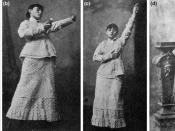Hypnosis: a highly controversial topic in the medical field. Capable of changing a person's behavior, modifying daily routines, causing odd reactions to normal things, plus countless other phenomena's. Many people believe that the mystic of hypnosis does not exist and is just a simple stage routine used for entertainment. But, in this report, I will prove that on the stage, in the therapy office, and in the mass public, Hypnosis does exist and is capable of changing our behavior and that it is a very delicate process and not a power to be taken lightly.
First I will start with a brief history of the art of Hypnosis and what it is. Hypnosis is the term for a state of the body where the mind is subconsciously active but the conscious mind and the body are in a sleep like state (although many consider it sleep, it actually isn't) (Hunter).
The change in these states is from "Beta" into "Alpha". Beta and Alpha are different terms used to describe the brain waves given off during these states. When the subconscious (subcon) or "Alpha" mind is responding, different commands, or suggestions, can be implemented into the mind. The subcon mind can then execute these imbedded commands without any intervening of the conscious mind and body (Hunter).
Hypnosis was first confirmed to be real by a Swedish therapist named Anton Mesmer around 1775. After publishing papers describing the Alpha Mind State, he named the entire process "Mesmerism". When a person was hypnotized, they were considered "Mesmerized" (Hyde 84). He would mesmerize them by swinging a watch in front of them while implementing the suggestions that send someone into a hypnotic sleep. More on this will be explained later on. It wasn't until 1841 that a doctor name James Baird gave the...


